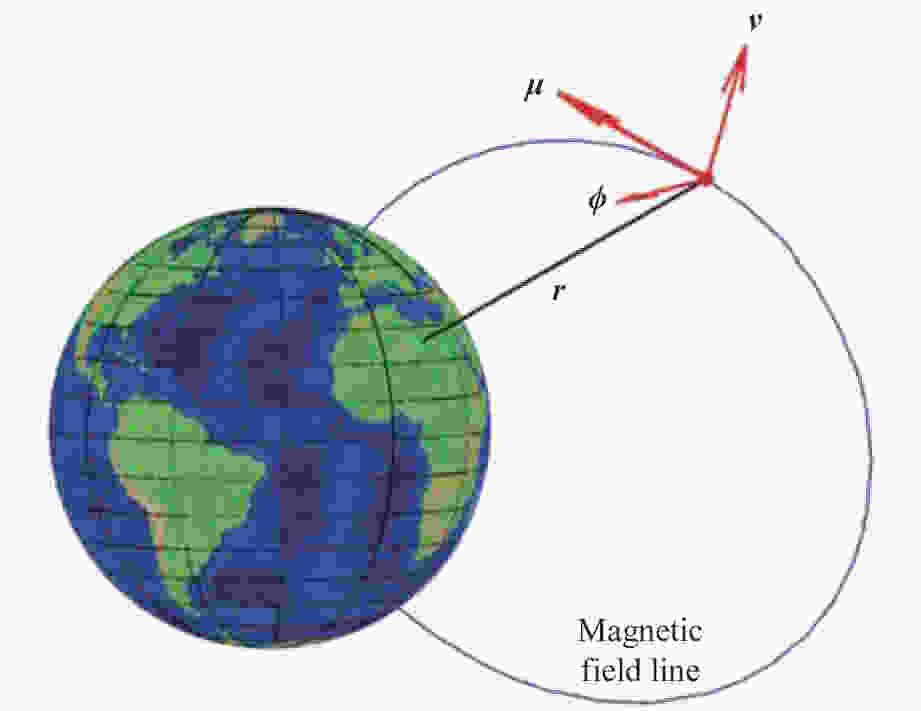Magnetic Signatures and Identification of Equatorial Plasma Bubbles
-
摘要: 等离子体泡是赤道区电离层常见的密度耗空结构,同时伴随着背景磁场的增强和垂直背景磁场方向上的扰动,这些扰动具有阿尔芬波的特征。本文利用Swarm卫星的标量、矢量磁场以及等离子体观测数据,考察了等离子体泡产生的磁场扰动信号特征,发现磁场强度和平均场向分量的增强均与等离子体泡密度下降有较强的负相关性,说明磁场标量和矢量(平均场向分量)数据都可以用来识别等离子体泡。由于Swarm卫星的标量磁场数据噪声明显低于矢量磁场数据,利用标量磁场数据可以提高等离子体泡的识别率,识别更多波动较小的等离子体泡。Abstract: Equatorial Plasma Bubbles (EPBs) are density depleted structures in the equatorial ionosphere, accompanied by the enhanced magnetic field strength, and fluctuations in the directions transverse to the main field, which have Alfvenic wave signatures. Utilizing the scalar, vector magnetic field, and plasma data from the Swarm mission, the magnetic signatures related with EPB are investigated. It is found that the changes both in the magnetic field strength and the component parallel with the main field are anti-correlated with the density changes inside EPBs, suggesting both the scalar and vector magnetic field data could be used to identify EPSs. Comparing the results of EPB identification using Swarm satellite scalar and vector magnetic field data products respectively, it is confirmed using the scalar data can increase the chance to identify EPBs, especially to find EPBs with relatively lower field fluctuations, since the noise level of the Swarm scalar magnetometer is about one order of magnitude lower than that of the vector magnetometer.
-
图 3 2015年2月5日等离子体泡。(a)高通滤波后的图2(a)磁场平均场向分量,(b)磁场平均场向分量的幅值,(c) Swarm观测的电子密度,(d)高通滤波后的电子密度
Figure 3. Plasma bubble on 5 February 2015. (a) High pass filtered main field aligned component in Fig.2(a), (b) amplitude of the component, (c) electron density observed by Swarm, (d) high pass filtered electron density
图 5 等离子体泡对应的磁场三分量和标量。(a)(b)(c)依次对应图2的μ
$ {\phi }{\nu } $ 方向,(d)为磁场强度Figure 5. Three components in MFA coordinates and strength of the magnetic field corresponding to the plasma bubble on 5 February 2015. (a)(b)(c) corresponds to the μ
$ {\phi }{\nu } $ components in Fig.2, (d) is magnetic field strength图 6 2015年2月5日等离子体泡滤波后磁场各分量之间的相关性。(a)平均场向与西向分量,(b)平均场向与径向分量,(c)平均场向与磁场强度,(d)磁场强度与等离子体密度
Figure 6. Correlation between the filtered components of the magnetic field in MFA coordinates of the plasma bubble on 5 February 2015. (a) Parallel and zonal component, (b) parallel and radial component, (c) parallel component and magnetic field strength, (d) magnetic field strength and plasma density
图 8 2015年2月7日的等离子体泡。(a)滤波后的平均场向磁场,(b)对图(a)的结果整流,(c)滤波后的标量磁场,(d)对图(c)的结果整流,(e)滤波后的等离子体密度
Figure 8. Plasma bubble on 7 February 2015. (a) Parallel magnetic field component filtered in MFA coordinate, (b) rectified result of (a), (c) scalar magnetic field filtered, (d) rectified result of (c), (e) plasma density filtered
表 1 利用两种数据识别等离子体泡的结果
Table 1. Results of the plasma bubble identification using two sets of data
识别用数据 识别成功 识别失败 事件总数 平均场向磁场 327 45 372 标量磁场 309 63 372 -
[1] PARK J, NOJA M, STOLLE C, et al. The Ionospheric Bubble Index deduced from magnetic field and plasma observations onboard Swarm[J]. Earth, Planets and Space, 2013, 65(11): 1333-1344 doi: 10.5047/eps.2013.08.005 [2] STOLLE C, LÜHR H, ROTHER M, et al. Magnetic signatures of equatorial spread F as observed by the CHAMP satellite[J]. Journal of Geophysical Research: Space Physics, 2006, 111(A2): A02304 [3] LÜHR H, ROTHER M, MAUS S, et al. The diamagnetic effect of the equatorial appleton anomaly: its characteristics and impact on geomagnetic field modeling[J]. Geophysical Research Letters, 2003, 30(17): 1906 [4] BURKE W J, GENTILE L C, HUANG C Y, et al. Longitudinal variability of equatorial plasma bubbles observed by DMSP and ROCSAT-1[J]. Journal of Geophysical Research: Space Physics, 2004, 109(A12): A12301 doi: 10.1029/2004JA010583 [5] LI G, NING B, LIU L, et al. Effect of magnetic activity on plasma bubbles over equatorial and low-latitude regions in East Asia[J]. Annales Geophysicae, 2009, 27(1): 303-312 doi: 10.5194/angeo-27-303-2009 [6] HUANG C M, RICHMOND A D, CHEN M Q. Theoretical effects of geomagnetic activity on low-latitude ionospheric electric fields[J]. Journal of Geophysical Research: Space Physics, 2005, 110(A5): A05312 [7] LÜHR H, MAUS S, ROTHER M, et al. First in-situ observation of night-time F region currents with the CHAMP satellite[J]. Geophysical Research Letters, 2002, 29(10): 1489 [8] PALMROTH M, LAAKSO H, FEJER B G, et al. DE 2 observations of morningside and eveningside plasma density depletions in the equatorial ionosphere[J]. Journal of Geophysical Research: Space Physics, 2000, 105(A8): 18429-18442 doi: 10.1029/1999JA005090 [9] KELLEY M C. The Earth's Ionosphere[M]. San Diego: Academic Press, 1989 [10] LUHR H, PARK J, XIONG C, et al. Alfven wave characteristics of equatorial plasma irregularities in the ionosphere derived from CHAMP observations[J]. Frontiers in Physics, 2014, 2: 47 [11] FRATTER I, LÉGER J M, BERTRAND F, et al. Swarm absolute scalar magnetometers first in-orbit results[J]. Acta Astronautica, 2016, 121: 76-87 doi: 10.1016/j.actaastro.2015.12.025 [12] FRIIS-CHRISTENSEN E, LÜHR H, HULOT G. Swarm: a constellation to study the Earth's magnetic field[J]. Earth, Planets and Space, 2006, 58(4): 351-358 doi: 10.1186/BF03351933 [13] REGI M, CORPO A D, LAURETIS M D. The use of the empirical mode decomposition for the identification of mean field aligned reference frames[J]. Annals of Geophysics, 2017, 59(6): G0651-G0667 [14] PARK J, LÜHR H, STOLLE C, et al. The characteristics of field-aligned currents associated with equatorial plasma bubbles as observed by the CHAMP satellite[J]. Annales Geophysicae, 2009, 27(7): 2685-2697 doi: 10.5194/angeo-27-2685-2009 [15] 汪领, 尹凡. 利用聚类算法区分小尺度电离层行扰事件与赤道等离子体泡事件[J]. 空间科学学报, 2020, 40(6): 1014-1023 doi: 10.11728/cjss2020.06.1014WANG Ling, YIN Fan. Distinguish small-scale traveling ionospheric disturbances and equatorial plasma bubbles by clustering algorithm[J]. Chinese Journal of Space Science, 2020, 40(6): 1014-1023 doi: 10.11728/cjss2020.06.1014 [16] YIN F, LÜHR H, PARK J, et al. Comprehensive analysis of the magnetic signatures of small-scale traveling ionospheric disturbances, as observed by Swarm[J]. Journal of Geophysical Research: Space Physics, 2019, 124(12): 10794-10815 doi: 10.1029/2019JA027523 [17] KIL H, PAXTON L J. Global distribution of nighttime medium-scale traveling ionospheric disturbances seen by swarm satellites[J]. Geophysical Research Letters, 2017, 44(18): 9176-9182 doi: 10.1002/2017GL074750 [18] MANDEA M M, KORTE M. Geomagnetic Observations and Models[M]. New York: Kiruna, 2011 [19] MAUS S, LÜHR H, ROTHER M, et al. Fifth-generation lithospheric magnetic field model from CHAMP satellite measurements[J]. Geochemistry, Geophysics, Geosystems, 2007, 8(5): Q05013 [20] OLSEN N, LÜHR H, FINLAY C C, et al. The CHAOS-4 geomagnetic field model[J]. Geophysical Journal International, 2014, 197(2): 815-827 doi: 10.1093/gji/ggu033 -
-






 下载:
下载:












